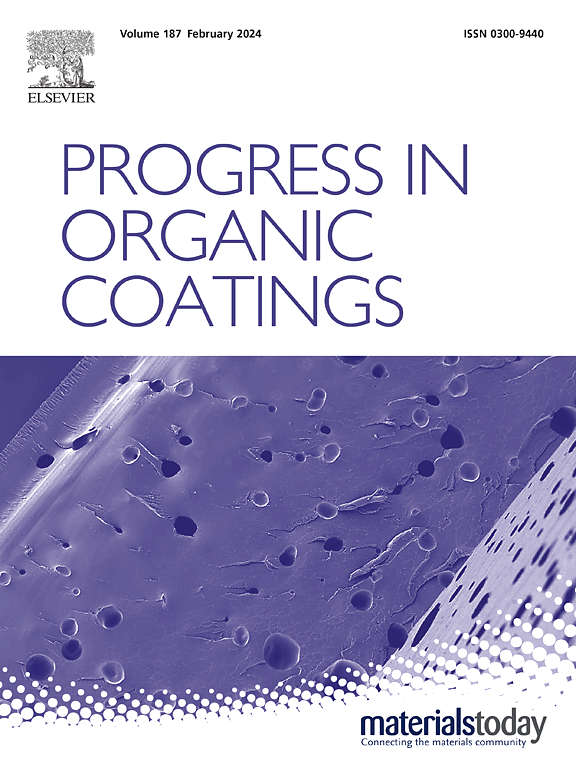基于梳状超分子的水性非硅树脂脱模涂料:合成、结构和性能
IF 6.5
2区 材料科学
Q1 CHEMISTRY, APPLIED
引用次数: 0
摘要
非硅酮释放涂层能够降低相邻表面之间的附着力,广泛应用于电子等领域。目前,它们主要由共价接枝制备的具有长烷基侧链的梳状聚合物组成,在合成和应用过程中通常需要大量的有机溶剂。以碳酸锆铵(AZC)为桥接剂,硬脂酸(SA)在聚乙烯醇(PVA)上非共价接枝,在水中合成了梳状超分子(SGP) PZS。研究了接枝量对SGP微相结构、结晶性能、表面性能和释放性能的影响。以[-OH]PVA: [Zr]AZC: [-COOH]SA = 2:1:2的最佳摩尔比制备的SGP释放膜的剥离强度(82.4±16.8 N/m)与共价接枝的涂层相当。最重要的是,新开发的PZS是水性的,在其整个生命周期(即合成和使用阶段)中挥发性有机化合物(VOCs)的释放几乎为零。新开发的水性SGP脱模剂是满足低剥离强度、低成本、环保等综合工业要求的有前途的脱模剂。本文章由计算机程序翻译,如有差异,请以英文原文为准。

Waterborne non‑silicone release coatings based on comb-like supramolecules: Synthesis, structure, and properties
Non‑silicone release coatings, which are capable of reducing the adhesion force between adjacent surfaces, are widely used in fields such as electronics. Currently, they consist of mainly comb-like polymers with long alkyl side chains prepared via covalent grafting and usually require a large amount of organic solvents both during the synthesis and application process. In this study, a comb-like supramolecule (SGP) named PZS was synthesized in water via non-covalent grafting of stearic acid (SA) on polyvinyl alcohol (PVA) with ammonium zirconium carbonate (AZC) as the bridging agent. The effects of grafting amount on the microphase structure, crystallization properties, surface properties, and release performance of SGP were investigated. The release coatings prepared from the aqueous solution of SGP with an optimal molar ratio of [-OH]PVA: [Zr]AZC: [-COOH]SA = 2:1:2 were found to display a low peel strength (82.4 ± 16.8 N/m) comparable to that of covalently grafted ones. Most importantly, the newly developed PZS is waterborne and achieved nearly zero release of volatile organic compounds (VOCs) throughout their entire life cycle (i.e. synthesis and use stage). The newly developed waterborne SGP are promising release agent candidates that fulfill comprehensive industrial requirements of low peel strength, low cost, and environmental friendliness.
求助全文
通过发布文献求助,成功后即可免费获取论文全文。
去求助
来源期刊

Progress in Organic Coatings
工程技术-材料科学:膜
CiteScore
11.40
自引率
15.20%
发文量
577
审稿时长
48 days
期刊介绍:
The aim of this international journal is to analyse and publicise the progress and current state of knowledge in the field of organic coatings and related materials. The Editors and the Editorial Board members will solicit both review and research papers from academic and industrial scientists who are actively engaged in research and development or, in the case of review papers, have extensive experience in the subject to be reviewed. Unsolicited manuscripts will be accepted if they meet the journal''s requirements. The journal publishes papers dealing with such subjects as:
• Chemical, physical and technological properties of organic coatings and related materials
• Problems and methods of preparation, manufacture and application of these materials
• Performance, testing and analysis.
 求助内容:
求助内容: 应助结果提醒方式:
应助结果提醒方式:


